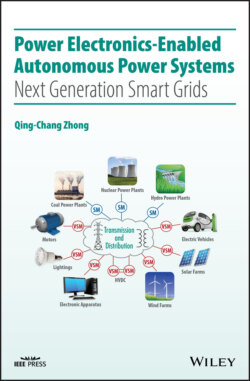Читать книгу Power Electronics-Enabled Autonomous Power Systems - Qing-Chang Zhong - Страница 40
2.7 Primary Frequency Response (PFR) in a SYNDEM Smart Grid
ОглавлениеMaintaining the stability of frequency is a top priority in power systems operation. There are three types of overlapping frequency control (Illian H. et al. 2017):
(1) Primary frequency control, which is any action provided on an interconnection to stabilize frequency in response to a change frequency. Primary frequency control comes from an automatic generator governor response (also known as speed regulation) and a load response (load damping), typically from motors and other devices that provide an immediate response based on local (device‐level frequency responsive) control systems or device characteristics.
(2) Secondary frequency control, which is any action provided by an individual control area (CA), balancing authority (BA), or its reserve sharing group to correct the resource–load imbalance that creates the original frequency deviation, and restores both scheduled frequency and primary frequency responsive reserves. Secondary control comes from either manual or automated dispatch from a centralized control system to correct frequency error.
(3) Tertiary frequency control, which is any action provided by control areas on a balanced basis that is coordinated so there is a net zero effect on the area control error (ACE). Examples of tertiary control include the dispatching of generation to serve native load, economic dispatch to affect interchange, and the re‐dispatching of generation. Tertiary control actions are intended to restore secondary control reserves by reconfiguring reserves.
The US Federal Energy Regulatory Commission (FERC) requires newly interconnecting large and small generating facilities, both synchronous and non‐synchronous, to install, maintain, and operate equipment capable of providing primary frequency response as a condition of interconnection (FERC 2018). Since all SMs and VSMs can provide primary frequency control or PFR against frequency excursions, a SYNDEM smart grid naturally meets this FERC requirement. Moreover, the loads interfaced with power electronic converters are able to provide PFR as well. It is expected that this will be required by the regulatory commissions in the US and other countries in the near future.
It is envisioned that, eventually, no secondary or tertiary frequency control is needed for a SYNDEM grid because all players can autonomously take part in system regulation.
